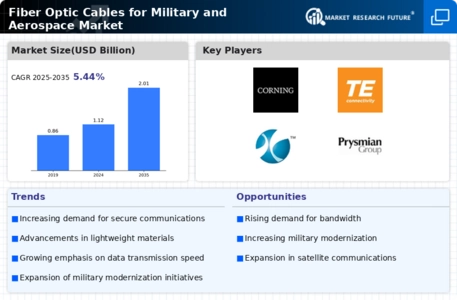-
Executive Summary
-
Market Attractiveness Analysis
-
Global Fiber Optic Cables for Military
-
and Aerospace Market, by Type
-
Global Fiber Optic Cables for Military
-
and Aerospace Market, by Application
-
Global Fiber Optic Cables for Military
-
and Aerospace Market, by End Use
-
Global Fiber Optic Cables for Military
-
and Aerospace Market, by Region
-
Market Introduction
-
Market Definition
-
Scope of the Study
-
Market Structure
-
Key Buying Criteria
-
Market Factor Indicator Analysis
-
Research Methodology
-
Research
-
Process
-
Primary Research
-
Secondary Research
-
Market
-
Size Estimation
-
Forecast Model
-
List of Assumptions
-
Market
-
Insights
-
Market Dynamics
-
Introduction
-
Drivers
- Increase in need for
- Rising focus of authorities on replacement of existing
- Drivers Impact Analysis
-
Increasing demand for throughput and reliability
-
lightweight systems
-
old cables
-
Restraints
- Issues related
- Stringent regulatory norms
- Restraints Impact Analysis
-
Complex maintenance and installation of fiber optic cables
-
to physical damage and transmission loss
-
Opportunities
-
Market/Technological
-
Trends
-
Patent Trends
-
Regulatory Landscape/Standards
-
Market Factor Analysis
-
Supply Chain Analysis
- R&D
- Distribution & Sales
- Post-Sales Monitoring
-
Manufacturing
-
Porter’s Five Forces Analysis
- Threat of New Entrants
- Bargaining Power of Suppliers
- Bargaining Power of Buyers
- Threat of Substitutes
- Intensity of Rivalry
-
Global Fiber
-
Optic Cables for Military and Aerospace Market, by Type
-
Introduction
-
Single-mode
-
Multi-mode
-
Global Fiber Optic Cables for Military
-
and Aerospace Market, by Application
-
Introduction
-
Avionics
-
Cabin Interiors
-
Communication Systems
-
Electronic Warfare
-
Flight Management Systems
-
In-Flight Entertainment (IFE) Systems
-
Radar Systems
-
Others
-
Global Fiber Optic Cables for Military
-
and Aerospace Market, by End Use
-
Introduction
-
Commercial
-
Military
-
Space
-
Global Fiber Optic Cables for Military
-
and Aerospace Market, by Region
-
Introduction
-
North America
- US
- Canada
-
Europe
- UK
- France
- Italy
- Russia
-
Germany
-
Rest of Europe
-
Asia-Pacific
- China
- India
- Japan
- South Korea
- Rest of Asia-Pacific
- Latin America
- Middle East & Africa
-
Rest of the World
-
Competitive Landscape
-
Competitive Overview
-
Competitor
-
Dashboard
-
Major Growth Strategies in the Global Fiber Optic Cables for
-
Military and Aerospace Market
-
Competitive Benchmarking
-
Market
-
Share Analysis
-
Leading Player in Terms of Number of Developments in the
-
Global Fiber Optic Cables for Military and Aerospace Market
-
Key Developments
- Product Launches/Service Deployments
- Joint Ventures
-
& Growth Strategies
-
Mergers & Acquisitions
-
Company Profiles
-
Key Market Players
-
(Company overview, products & services offered,
-
financial overview, key developments, SWOT analysis, and key strategies to be covered
-
for public companies)
-
Amphenol Corporation
-
Raytheon Technologies
-
Corporation
-
Carlisle Interconnect Technologies
-
Corning Incorporated
-
Finisar Corporation
-
W. L. Gore & Associates, Inc.
-
OFS Fitel, LLC
-
AFL
-
Optical Cable Corporation
-
TE Connectivity
-
Radiall
-
Prysmian Group
-
Timbercon,
-
Inc.
-
Appendix
-
References
-
Related Reports
-
List of Abbreviations
-
-
List of Tables
-
List of Assumptions
-
Major Patents Granted for Fiber Optic Cables Market for Military and Aerospace
-
(2020–2030)
-
Global Fiber Optic Cables for Military and Aerospace
-
Market, by Type, 2020–2030 (USD Million)
-
Global Fiber Optic Cables
-
for Military and Aerospace Market, by Application, 2020–2030(USD Million)
-
Global Fiber Optic Cables for Military and Aerospace Market, By End Use,
-
Global Fiber Optic Cables for Military
-
and Aerospace Market, by Region, 2020–2030 (USD Million)
-
North
-
America: Fiber Optic Cables for Military and Aerospace Market, by Country, 2020–2030(USD
-
Million)
-
North America: Fiber Optic Cables for Military and Aerospace
-
Market, by Type, 2020–2030 (USD Million)
-
North America: Fiber
-
Optic Cables for Military and Aerospace Market, by Application, 2020–2030
-
(USD Million)
-
North America: Fiber Optic Cables for Military and Aerospace
-
Market, By End Use, 2020–2030 (USD Million)
-
US: Fiber Optic
-
Cables for Military and Aerospace Market, by Type, 2020–2030 (USD Million)
-
US: Fiber Optic Cables for Military and Aerospace Market, by Application,
-
US: Fiber Optic Cables for Military
-
and Aerospace Market, by End Use, 2020–2030 (USD Million)
-
Canada:
-
Fiber Optic Cables for Military and Aerospace Market, by Type, 2020–2030 (USD
-
Million)
-
Canada: Fiber Optic Cables for Military and Aerospace Market,
-
by Application, 2020–2030 (USD Million)
-
Canada: Fiber Optic
-
Cables for Military and Aerospace Market, by End Use, 2020–2030 (USD Million)
-
Europe: Fiber Optic Cables for Military and Aerospace Market, by Country,
-
Europe: Fiber Optic Cables for Military
-
and Aerospace Market, by Type, 2020–2030 (USD Million)
-
Europe:
-
Fiber Optic Cables for Military and Aerospace Market, by Application, 2020–2030
-
(USD Million)
-
Europe: Fiber Optic Cables for Military and Aerospace
-
Market, by End Use, 2020–2030 (USD Million)
-
UK: Fiber Optic
-
Cables for Military and Aerospace Market, by Type, 2020–2030 (USD Million)
-
UK: Fiber Optic Cables for Military and Aerospace Market, by Application,
-
UK: Fiber Optic Cables for Military
-
and Aerospace Market, by End Use, 2020–2030 (USD Million)
-
Germany:
-
Fiber Optic Cables for Military and Aerospace Market, by Type, 2020–2030 (USD
-
Million)
-
Germany: Fiber Optic Cables for Military and Aerospace Market,
-
by Application, 2020–2030 (USD Million)
-
Germany: Fiber Optic
-
Cables for Military and Aerospace Market, by End Use, 2020–2030 (USD Million)
-
France: Fiber Optic Cables for Military and Aerospace Market, by Type,
-
France: Fiber Optic Cables for Military
-
and Aerospace Market, by Application, 2020–2030 (USD Million)
-
TABLE 29
-
France: Fiber Optic Cables for Military and Aerospace Market, by End Use, 2020–2030
-
(USD Million)
-
Italy: Fiber Optic Cables for Military and Aerospace
-
Market, by Type, 2020–2030 (USD Million)
-
Italy: Fiber Optic
-
Cables for Military and Aerospace Market, by Application, 2020–2030 (USD Million)
-
Italy: Fiber Optic Cables for Military and Aerospace Market, by End Use,
-
Russia: Fiber Optic Cables for Military
-
and Aerospace Market, by Type, 2020–2030 (USD Million)
-
Russia:
-
Fiber Optic Cables for Military and Aerospace Market, by Application, 2020–2030
-
(USD Million)
-
Russia: Fiber Optic Cables for Military and Aerospace
-
Market, by End Use, 2020–2030 (USD Million)
-
Rest of Europe:
-
Fiber Optic Cables for Military and Aerospace Market, by Type, 2020–2030 (USD
-
Million)
-
Rest of Europe: Fiber Optic Cables for Military and Aerospace
-
Market, by Application, 2020–2030 (USD Million)
-
Rest of Europe:
-
Fiber Optic Cables for Military and Aerospace Market, by End Use, 2020–2030
-
(USD Million)
-
Asia-Pacific: Fiber Optic Cables for Military and Aerospace
-
Market, by Country, 2020–2030 (USD Million)
-
Asia-Pacific: Fiber
-
Optic Cables for Military and Aerospace Market, by Type, 2020–2030 (USD Million)
-
Asia-Pacific: Fiber Optic Cables for Military and Aerospace Market, by
-
Application, 2020–2030 (USD Million)
-
Asia-Pacific: Fiber Optic
-
Cables for Military and Aerospace Market, by End Use, 2020–2030 (USD Million)
-
China: Fiber Optic Cables for Military and Aerospace Market, by Type,
-
China: Fiber Optic Cables for Military
-
and Aerospace Market, by Application, 2020–2030 (USD Million)
-
TABLE 45
-
China: Fiber Optic Cables for Military and Aerospace Market, by End Use, 2020–2030
-
(USD Million)
-
India: Fiber Optic Cables for Military and Aerospace
-
Market, by Type, 2020–2030 (USD Million)
-
India: Fiber Optic
-
Cables for Military and Aerospace Market, by Application, 2020–2030 (USD Million)
-
India: Fiber Optic Cables for Military and Aerospace Market, by End Use,
-
Japan: Fiber Optic Cables for Military
-
and Aerospace Market, by Type, 2020–2030 (USD Million)
-
Japan:
-
Fiber Optic Cables for Military and Aerospace Market, by Application, 2020–2030
-
(USD Million)
-
Japan: Fiber Optic Cables for Military and Aerospace
-
Market, by End Use, 2020–2030 (USD Million)
-
South Korea: Fiber
-
Optic Cables for Military and Aerospace Market, by Type, 2020–2030 (USD Million)
-
South Korea: Fiber Optic Cables for Military and Aerospace Market, by
-
Application, 2020–2030 (USD Million)
-
South Korea: Fiber Optic
-
Cables for Military and Aerospace Market, by End Use, 2020–2030 (USD Million)
-
Rest of Asia-Pacific: Fiber Optic Cables for Military and Aerospace Market,
-
by Type, 2020–2030 (USD Million)
-
Rest of Asia-Pacific: Fiber
-
Optic Cables for Military and Aerospace Market, by Application, 2020–2030
-
(USD Million)
-
Rest of Asia-Pacific: Fiber Optic Cables for Military
-
and Aerospace Market, by End Use, 2020–2030 (USD Million)
-
Rest
-
of the World: Fiber Optic Cables for Military and Aerospace Market, by Region, 2020–2030
-
(USD Million)
-
Rest of the World: Fiber Optic Cables for Military and
-
Aerospace Market, by Type, 2020–2030 (USD Million)
-
Rest of the
-
World: Fiber Optic Cables for Military and Aerospace Market, by Application, 2020–2030
-
(USD Million)
-
Rest of the World: Fiber Optic Cables for Military and
-
Aerospace Market, by End Use, 2020–2030 (USD Million)
-
Latin
-
America: Fiber Optic Cables for Military and Aerospace Market, by Type, 2020–2030
-
(USD Million)
-
Latin America: Fiber Optic Cables for Military and Aerospace
-
Market, by Application, 2020–2030 (USD Million)
-
Latin America:
-
Fiber Optic Cables for Military and Aerospace Market, by End Use, 2020–2030
-
(USD Million)
-
Middle East & Africa: Fiber Optic Cables for Military
-
and Aerospace Market, by Type, 2020–2030 (USD Million)
-
Middle
-
East & Africa: Fiber Optic Cables for Military and Aerospace Market, by Application,
-
Middle East & Africa: Fiber Optic
-
Cables for Military and Aerospace Market, by End Use, 2020–2030 (USD Million)
-
The Most Active Players in the Global Fiber Optic Cables for Military
-
and Aerospace Market
-
Contracts & Agreements
-
Mergers
-
& Acquisitions
-
Product/Service Developments
-
Expansions
-
& Investments
-
Joint Ventures & Partnerships
-
-
List of Figures
-
Market Synopsis
-
Global Fiber Optic
-
Cables for Military and Aerospace Market: Market Attractiveness Analysis
-
Figure
-
Global Fiber Optic Cables for Military and Aerospace Market Analysis, by Type
-
Global Fiber Optic Cables for Military and Aerospace Market Analysis,
-
by Application
-
Global Fiber Optic Cables for Military and Aerospace
-
Market Analysis, by End Use
-
Global Fiber Optic Cables for Military
-
and Aerospace Market Analysis, by Region
-
Global Fiber Optic Cables
-
for Military and Aerospace Market: Market Structure
-
Key Buying Criteria
-
for Fiber Optic Cables Market for Military and Aerospace Technologies
-
Figure
-
Research Process of MRFR
-
North America: Market Size & Market
-
Share, by Country, 2020 vs 2030
-
Europe: Market Size & Market
-
Share, by Country, 2020 vs 2030
-
Asia-Pacific: Market Size & Market
-
Share, by Country, 2020 vs 2030
-
Rest of the World: Market Size &
-
Market Share, by Region, 2020 vs 2030
-
Market Dynamics Overview
-
Drivers Impact Analysis: Global Fiber Optic Cables for Military and
-
Aerospace Market
-
Restraints Impact Analysis: Global Fiber Optic Cables
-
for Military and Aerospace Market
-
Porter’s Five Forces Analysis
-
of the Global Fiber Optic Cables for Military and Aerospace Market
-
Figure 18
-
Supply Chain: Global Fiber Optic Cables for Military and Aerospace Market
-
Figure
-
Global Fiber Optic Cables for Military and Aerospace Market Share, by Type, 2020
-
(% Share)
-
Global Fiber Optic Cables for Military and Aerospace Market
-
Share, by Application, 2020 (% Share)
-
Global Fiber Optic Cables for
-
Military and Aerospace Market Share, by End Use, 2020 (% Share)
-
Global
-
Fiber Optic Cables for Military and Aerospace Market Share, by Region, 2020 (% Share)
-
North America: Fiber Optic Cables for Military and Aerospace Market
-
Share, by Country, 2020 (% Share)
-
Europe: Fiber Optic Cables for
-
Military and Aerospace Market Share, by Country, 2020 (% Share)
-
Asia-Pacific:
-
Fiber Optic Cables for Military and Aerospace Market Share, by Country, 2020 (%
-
Share)
-
Rest of the World: Fiber Optic Cables for Military and Aerospace
-
Market Share, by Region, 2020 (% Share)
-
Competitor Dashboard: Global
-
Fiber Optic Cables for Military and Aerospace Market
-
Capital Market
-
Ratio and Financial Matrix
-
Contracts & Agreements: The Major
-
Strategy Adopted by Key Players in the Global Fiber Optic Cables for Military and
-
Aerospace Market
-
Benchmarking of Major Competitors
-
Figure 31
-
Major Service Providers Market Share Analysis, 2020

















Leave a Comment